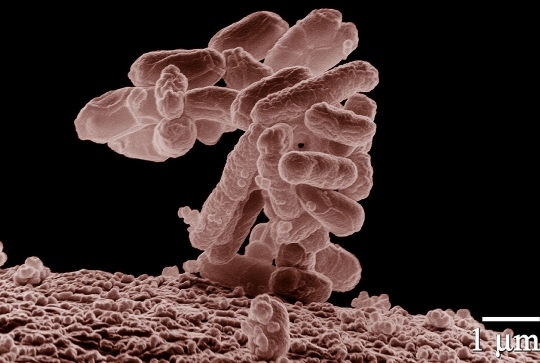Another Creationist Prediction Confirmed

A cluster of the bacteria discussed in the article
Dr. Richard Lenski, an evolutionary biologist at Michigan State University, has been running a long-term experiment on evolution. Indeed, it has been named the LTEE (Long-Term Evolution Experiment). It started back in 1988 and is still running today. It has followed 12 populations of the bacterium Escherichia coli through more than 50,000 generations, examining how environmental stress changes the bacteria’s genetic and physiological characteristics. More than 6 years ago, I discussed how the project was confirming the creationist view of the genome, and it continues to do just that. In addition, it has inspired another experiment that specifically confirmed a creationist prediction while, at the same time, falsifying an evolutionary one.
To understand what has happened, we need to go back to 2008. In that year, the LTEE showed that even though Escherichia coli normally can’t make use of a chemical called citrate when oxygen is present, one of the their populations developed that ability after 31,500 generations of existence.1 As a result, it was dubbed the “citrate plus” population. How did that happen? At the time, no one knew. However, evolutionists thought it was the result of some rare event or combination of events, exactly the kind upon which evolution depends. New Scientist put it this way:
By this time, Lenski calculated, enough bacterial cells had lived and died that all simple mutations must already have occurred several times over.
That meant the “citrate-plus” trait must have been something special – either it was a single mutation of an unusually improbable sort, a rare chromosome inversion, say, or else gaining the ability to use citrate required the accumulation of several mutations in sequence.
Lenski himself was bold enough to write:
So the bacteria in this simple flask-world have split into two lineages that coexist by exploiting their common environment in different ways. And one of the lineages makes its living by doing something brand-new, something that its ancestor could not do.
That sounds a lot like the origin of species to me. What do you think?
Not surprisingly, a recent experiment has shown that the evolutionary predictions of Lenski and New Scientist are wrong. At the same time, it demonstrated that the predictions of both intelligent design advocates and creationists were correct.
What was the experiment? It was an attempt to reproduce the LTEE’s results – repeatedly. If one of the evolution-inspired predictions was correct, it should be very, very hard to evolve a population of citrate-using Escherichia coli in an oxygen environment. After all, Lenski believed that this was the origin of a new species, and that should be very rare. Indeed, as New Scientist indicated, the ability to use citrate in the presence of oxygen was “something special” that required “rare” conditions. However, there were scientists with another view of the situation. Intelligent design advocates suggested it as well, but I will quote a creationist (Dr. Georgia Purdom) who suggested it:
Mutations which lead to adaptation, termed adaptive mutations, can readily fit within a creation model where adaptive mechanisms are a designed feature of bacteria allowing them to survive in a fallen world. Since E. coli already possess the ability to transport and utilize citrate under certain conditions, it is conceivable that they could adapt and gain the ability to utilize citrate under broader conditions. This does not require the addition of new genetic information or functional systems… (emphasis mine)
If Dr. Purdom is correct, it shouldn’t be at all difficult to produce citrate-using Escherichia coli in an oxygen environment. Adaptive mutations are part of a designed mechanism that produces predictable results in the presence of environmental stress. Thus, given the correct environmental stress, you should repeatedly get the same adaptive result. What did the experiment find? It repeatedly got the Escherichia coli to develop the ability to use citrate in the presence of oxygen, as long as the environmental stress was consistent. Here is how the authors put it:2
Using similar media, 46 independent citrate-utilizing mutants were isolated in as few as 12 to 100 generations. Genomic DNA sequencing revealed an amplification of the citT and dctA loci and DNA rearrangements to capture a promoter to express CitT, aerobically. These are members of the same class of mutations identified by the LTEE. We conclude that the rarity of the LTEE mutant was an artifact of the experimental conditions and not a unique evolutionary event. No new genetic information (novel gene function) evolved. (emphasis mine)
In other words, they were able to repeatedly get the same results as the LTEE very quickly. That means there was no “rare” set of events leading to the ability to use citrate in the presence of oxygen, and this was definitely not any kind of speciation event. Instead, the same genetic changes seen in the LTEE were achieved repeatedly after a short amount of time. This tells us that the ability to use citrate in the presence of oxygen is the result of adaptive mutation, as predicted by Dr. Purdom nearly 8 years ago.
I would also point out the conclusion that I highlighted with boldface type. The researchers conclude that no new genetic information was needed to produce this change. This had been determined back in 2012, confirming what both intelligent design advocates and creationists had predicted, but it is nice to see it clearly spelled out in the scientific literature.
REFERENCES
Jay L. Wile's Blog
- Jay L. Wile's profile
- 31 followers



